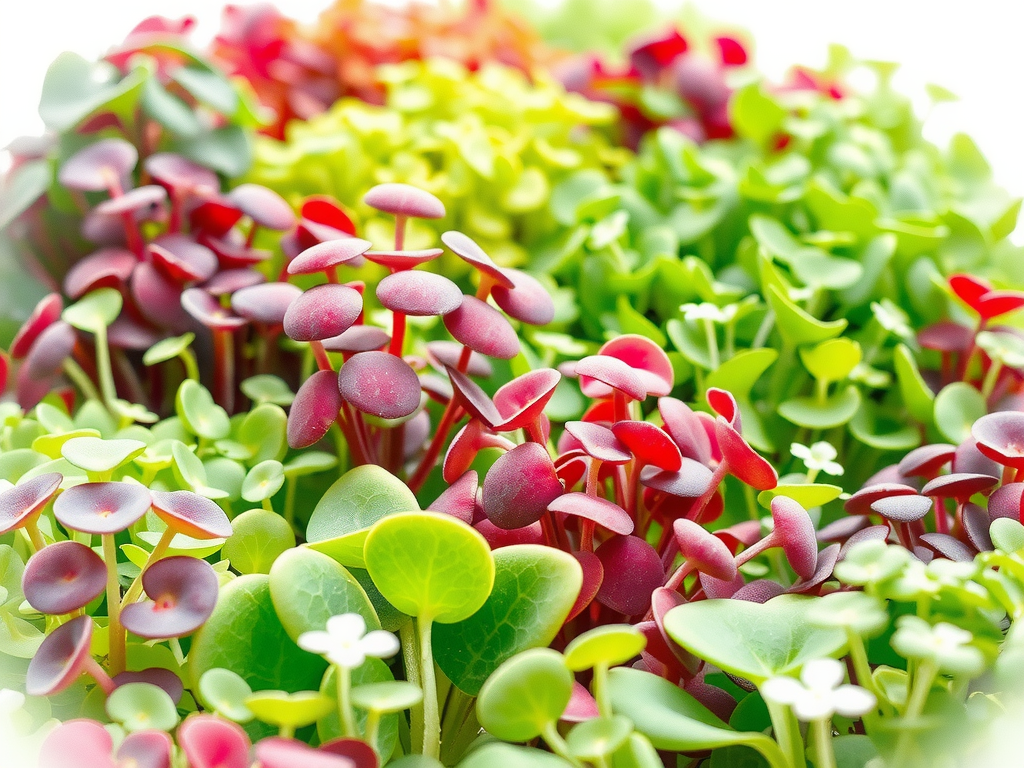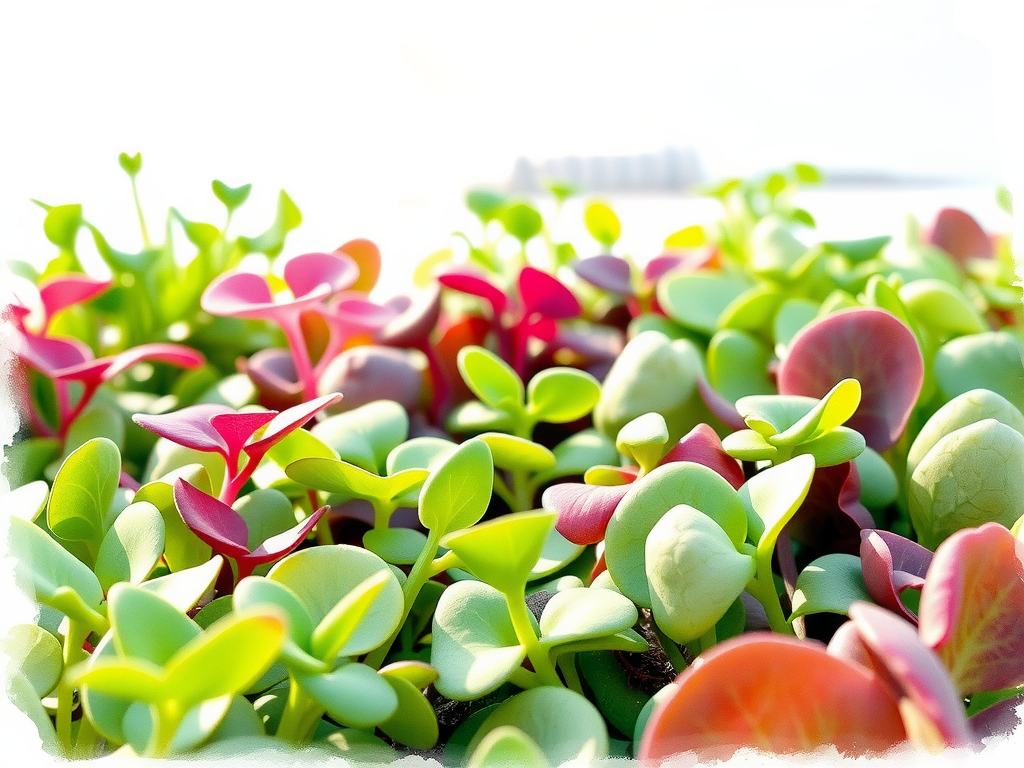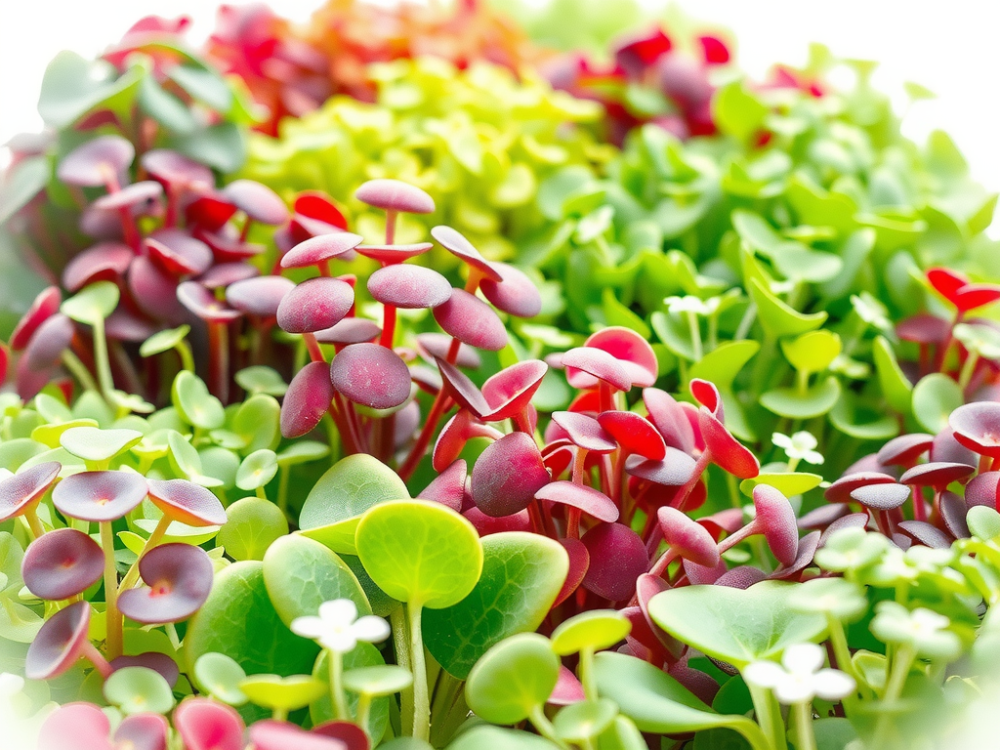
Microgreens are young seedlings that bring nutrition and flavor to salads. These nutrient-dense plants, harvested 7–21 days after germination, come in vibrant colors and bold flavors.
Arugula adds a peppery kick, and broccoli provides a mild, nutrient-rich base.
Pea shoots offer a sweet, crunchy texture.
Adding these ingredients enhances both taste and nutrition. Sunflower greens bring a nutty flavor, while radish microgreens contribute a spicy twist.
Research shows they can have up to 40 times more nutrients than mature plants, making microgreens perfect for salads that look good and promote health.
Click here to learn more about: best microgreens to grow for beginners
Choosing Nutrient-Dense Microgreens For Salads
Choosing healthy microgreens boosts salad nutrition. Nutrient-dense choices like kale, broccoli, and beet greens are rich in vitamins and antioxidants.
They pair well with different salad ingredients.
For instance, add radish microgreens for spice and sunflower greens for crunch.
When shopping, check for freshness; look for vibrant colors and firm textures. Avoid wilted greens to maximize flavor and health benefits.
Combining various microgreens makes salads more exciting and nutritious.
Popular Microgreens
Microgreens like arugula, broccoli, and pea shoots are excellent for salads. They provide unique flavors and many health benefits.
Arugula is peppery and rich in vitamins A and K.
Broccoli contains sulforaphane, which supports heart health.
Pea shoots are sweet and high in vitamins A and C.
Tips for Selecting Fresh Microgreens
Look for microgreens that are vibrant and crisp.
Fresh microgreens enhance salads with their flavors and nutrients. Avoid any that appear wilted or brown.
Health Benefits of Microgreens
Microgreens are not just visually appealing; they are also nutritional powerhouses.
They are packed with vitamins, minerals, and antioxidants. Regular consumption of microgreens can support health, help prevent chronic illnesses, and improve heart health.
Adding them to salads or other meals boosts overall nutrition and flavor.

How Do Pea Shoots Enhance Flavor
Pea shoots bring a refreshing sweetness to salads. This sweetness contrasts well with other greens.
Their fresh flavor profile enhances both taste and texture, making them a favorite for salad lovers.
Compared to bitter greens like arugula, pea shoots provide a perfect balance.
This balance complements various ingredients beautifully.
To amplify taste, consider these pairing ideas:
- Citrus fruits: Add zest and contrast.
- Nuts: Mixing in nuts adds crunch and protein.
- Creamy dressings: These can further enhance flavors.
Overall, pea shoots are among the best microgreens for salads. They elevate the dish’s flavor and nutrition.
Benefits Of Radish Microgreens In Salads
Radish microgreens add a spicy kick to any salad. Their crunchy texture is a delightful addition. These microgreens are also visually appealing due to their vibrant colors. High in antioxidants, they help protect against oxidative stress. Radish microgreens are rich in Vitamin E, supporting skin health and boosting the immune system.
For a creative twist, consider these ideas:
- Add radish microgreens to sandwiches for extra flavor.
- Include them in grain bowls for a crunchy texture.
- Use them as a salad garnish to enhance visual appeal.
Using radish microgreens can add a burst of nutrient-dense freshness to your meals.
Pea Shoots and Radish Microgreens
- Pea shoots are low in calories and high in vitamins A, C, and K.
- Radish microgreens contain up to 40 times more nutrients than mature radish plants.
- Both microgreens are easy to grow at home, making them accessible for fresh ingredients.
- Incorporating microgreens into meals can contribute to a balanced diet rich in antioxidants.
Exploring The Bold Flavors Of Arugula
Arugula is a nutrient-dense leafy green known for its peppery flavor. This microgreen makes a delicious addition to salads, often combined with milder greens.
It pairs well with fruits like pears and apples and cheeses such as goat cheese.
To balance arugula’s bold taste, try mixing it with spinach or romaine.
This combination softens its earthy flavor while keeping a satisfying crunch. Arugula is rich in vitamins A and K, making it a nutritional powerhouse for any meal.
Why Sunflower Greens Are Salad Favorites
Sunflower greens are high-fiber microgreens loved for their crunchy texture and vibrant look in salads.
Their unique nutty flavor enhances dishes significantly. These greens work well with fresh ingredients, bringing a delightful taste to every bite.
Pairing sunflower greens with a simple lemon vinaigrette highlights their natural sweetness and brightness.
Their rich protein and Vitamin E content make them a nutritional powerhouse.
Sunflower greens not only add flavor but also improve the visual appeal of meals, making them ideal for salad toppings.
Arugula and Sunflower Greens
- Arugula contains high levels of vitamins A and K, essential for maintaining healthy vision and bone health.
- Sunflower greens are an excellent source of protein and Vitamin E, promoting overall health and wellness.
- Both arugula and sunflower greens add unique flavors to salads, enhancing the overall taste experience.
- These microgreens are visually appealing, making salads more attractive and appetizing.
Nutritional Powerhouse: Broccoli Microgreens
Broccoli microgreens are nutrient-dense young seedlings filled with health benefits. These microgreens offer high concentrations of vitamins A, C, E, and K, essential for overall health.
They contain minerals like calcium, iron, and potassium.
Studies indicate that broccoli microgreens can have up to 40 times more nutrients than mature plants.
Adding these microgreens to your salads is simple; use small amounts for a mild flavor boost. Mix them with other leafy greens to balance flavors without overpowering your dish.
They also serve as a fresh salad garnish, enhancing both taste and appearance.
Health Benefits of Broccoli Microgreens
Broccoli microgreens are rich in sulforaphane, which supports cardiovascular health and aids in digestive health. Regular consumption of these microgreens may help reduce the risk of chronic illness.
They are also packed with antioxidants, promoting overall wellness and nutrient absorption.
Creative Salad Toppings With Red Cabbage
Red cabbage adds texture and stunning color to salads.
This nutrient-rich vegetable is high in vitamins C and K, enhancing its health benefits.
To incorporate red cabbage, try shredding it finely for a crisp texture that adds visual appeal. You can mix it into slaws or pair it with other crunchy vegetables for a unique experience.
Preparing Red Cabbage
For a flavorful twist, consider pickling red cabbage; this adds tanginess and enhances its natural sweetness.
This versatile ingredient not only boosts nutrition but also transforms your salads into a colorful mix of flavors. Its earthy flavor balances well with other ingredients, making it a great addition to any dish.
Mixing Colors and Textures
Combining red cabbage with microgreens, like arugula or broccoli, creates a salad that is both visually appealing and nutrient-rich.
This mix ensures you’re enjoying a salad that is both healthy and delicious.
Broccoli Microgreens and Red Cabbage
- Broccoli microgreens can contain up to 40 times more nutrients than mature broccoli.
- Rich in sulforaphane, broccoli microgreens support cardiovascular and digestive health.
- Red cabbage is high in vitamins C and K, contributing to overall health benefits.
- Pickled red cabbage adds tanginess while enhancing the natural sweetness of salads.
Incorporating Wheatgrass Into Fresh Salads
Wheatgrass is a nutrient-dense addition to fresh salads. This young seedling offers vitamins A, C, and K, enhancing health benefits.
To balance its strong, earthy flavor, pair it with mild greens like arugula or cucumber.
Start with small amounts of wheatgrass, as its taste can easily overwhelm other ingredients.
Balancing Flavors in Your Salad
Combine wheatgrass with creamy avocado to achieve harmony in your salad.
Complementing dressings can also help smooth out bold flavors. A good dressing can enhance the overall taste, ensuring a delightful eating experience.
Experimenting with different combinations will allow you to enjoy the benefits of wheatgrass without overpowering your dish.
Best Microgreens for Salads
Many microgreens complement wheatgrass well. Here are some of the best:
- Arugula: Peppery flavor, rich in vitamins A and K.
- Broccoli: Mild taste with sulforaphane, supporting heart health.
- Pea Shoots: Sweet and crunchy, high in vitamins A and C.
- Sunflower: Nutty and slightly sweet, packed with protein.
- Radish: Spicy and crisp, adds boldness to your salad.
- Red Cabbage: Mildly sweet; visually appealing with purple colors.
- Beet Greens: Earthy flavor and rich in compounds for cardiovascular health.
- Kale: Nutritional powerhouse, high in antioxidants and fiber.
Microgreens can have 4–40 times the nutrients of their mature plants.
Using these microgreens in your salads can enhance both flavor and nutrition.
Wheatgrass and Microgreens
- Wheatgrass is rich in essential vitamins, including A, C, and K, which contribute to overall health.
- Microgreens can contain 4–40 times the nutrients of their mature counterparts, making them a powerful addition to salads.
- Combining wheatgrass with creamy ingredients like avocado can help balance its strong flavor in salads.
- Including a variety of microgreens enhances both the taste and nutritional profile of your salads.




